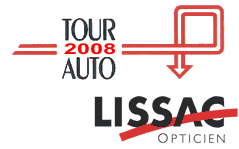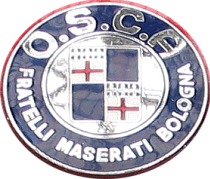 |
||
|
This year's Tour led the competitors from Paris to the Old Harbour of Marseilles. Nothing is easier than a Paris-Marseilles journey: jump into a train, take an airplane or get into a car and 770 km further you have reached your destination. Most convenient! But, the Tour does not aim for a handy solution, only looking for a pleasant trip. Thus, this Paris-Marseille 2008 route took five days, from race track to race track and from timed road stage to another, covering over 1800 km mostly on secondary country roads and leading through some of France’s most scenic regions like Burgundy, Auvergne with Volcanoes National Park and Dordogne river valley, the Cevennes Mountains with the Tarn river gorgeous and the Luberon Mountains close to the Mediterranean coast. Each crew had the choice to enroll their car in either Competition or Regularity class. Along the road sections, it was obviously the French Driving Code which layed down the law, hidden speed traps were in operation. Regarding the timed sessions (race track or closed road stage), in the Regularity section the most precise was the winner; in the Competition “pedal to the metal” was the motto, the fastest gained the crown. As each Tour Auto Lissac is themed, this year the Tour celebrated the 55th anniversary of the overall victory on TdF by OSCAs in 1953. Small engines, big achievements, the OSCAs shined on the TdF from 1952 to 1954. In 1953, an 1100cc MT4 spider won the event outright ahead of a 3-litre Gordini driven by Jean Behra! The OSCA MT4 can boast of having been driven by such racing luminaries as Alfonso de Portago and a regular on the Tour Auto Lissac Sir Sterling Moss, who drove an MT4 to victory in the 1954 12-Hours of Sebring Short history of O.S.C.A.
But back to 2008. On Tuesday, April 15th, the Tour official start was given from Fontainebleau 70km outside Paris by the end of the morning, avoiding the usual morning traffic jam inside Paris. The recent years many cars with the most fragile engines had problems (over-heating, vapour locks in the carbs, …) with the morning traffic hazards in Paris. The main court of the Château de Fontainebleau was just the right place to start such an event. All 230 cars, eligible models are those that entered in the original event between 1951 and 1973, got off on the right foot for today legs destination, Beaune. But the crews in their barchettas, exposed to the four winds anyway, also had to struggle with winter temperatures and a rare sun, which didn’t shined enough to dry up the particularly wet roads. The Fast and the Furious The first special road stage of the Tour is always longingly expected by the competitors, but care should be taken as all drivers, peppy and full of beans, have to get used to the road and weather conditions. After some rain and a hailstorm the mountain roads in the land of vineyards of Chablis were slippery like soft soap. The German Jürgen End on his extremely fast Alfa Romeo Giulia Super TI, en-route in the “pedal to the metal” group Competition, managed it very well and summed up: “The corners with gravel on the road should have been clearly marked but during a rally you can bargain for everything – and you have to have a way with it”. Some did, others don’t, they had an unexpected rendezvous with a ditch or found themselves somewhere in a vineyard. If there are some bottles of French Chablis less on sale next year, one can’t only blame the weather for it. The special road stage of Chablis also showed that this year the AC Cobras were candidates for the highest step on the winners’ rostrum, two Cobras in front of a Porsche 911. AC Cobras also accomplished the best time on the circuit of Dijon Prenois in front a Porsche 904 GTS. The Lotus Elan, winning car of the last seven years, had to struggle with technical problems or with the French scenery as two of those cars did not survive the first day. In Regularity it was once again the Linwoods who showed their skills in synchronizing gas pedal and chronometers. The English couple, regularity winner of the last two years on Giulia Super TI resp. Citroen SM , started this year on Porsche 911 RS 2.7L. The little “Green Hell” One of the highlights of the Tour was the well known Circuit de Charade
close to the City of Clermont-Ferrand. According to Sir Stirling Moss the Circuit des Charade was in its original
layout of 8.055 km a mixture of the “Nürburgring Nordschleife” and Spa Francorchamps and a real fun to drive on.
In the 60s and 70s the circuit hosted four Formula One races until it was displaced by the circuit of Le Castellet-Paul
Ricard. Due to security reasons the Circuit de Charade had to be shortened to 3.975 km in 1988 and it is still a
great fun to drive on.
Usually it’s a cloudy day when the Tour Auto stops at the Circuit de Charade.
But not this year, we even had some sun until the last laps of the last group of cars as finally the rain set in.
There had been some great fights between the Alfas and the Jaguars, especially as the German Jürgen End
on his innocent looking Giulia Super TI surprised the other competitors with his driving skills and the abilities of
his car. French country roads Driving on French country roads is almost like driving in New Zealand.
Beautiful scenery alternates with dozy little villages and the best thing of all: almost no or less traffic.
Besides admiring the scenery you have to be careful as well. These roads my surprise you with bumpy sections
especially at railway crossings where your cars exhaust is endangered, unexpected gravel on the road, very narrow
sections and even wandering stock on the road. Despite all obstacles flying over these roads with a bunch of old but
still fast going cars is almost like being in the lap of luxury. The Weather During this year's Tour we had all sorts of weather, starting from sunny but cold to
freezing and wet during the days. Beaune for instance saw an utterly cold night with freezing temperatures still in
the early morning. After getting the engines running the most sought after tool was an ice scraper to clear the
windows. As not every team was equipped with such a special high tech utility, some credit cards did not survive
this morning. While crossing the Cevennes Mountains on Friday, this day saw the most terrible
weather of the tour. We had rain and cold winds almost the whole day, snow at the mountain and torrential rainfall
at the days finish in Avignon. Most people felt really sorry for the crews driving in their barchettas and being exposed
to the four winds. Saturday reconciled all competitors with the French weather, a bright and warm
sunny day. And it even doesn’t bothered the competitors that the days first special road stage up the legendary
Mont Ventoux had to be cancelled due to show and ice on the roads. Safety goes first. Talking to competitors who
attended the Tour-Auto for many years the 2008 Tour had the most “terrible and interesting” weather ever since. Snake Pit This year saw not only the revenge of the AC Cobras ending a long-lived series of
victories of the Lotus Elan, it also saw a particularly thrilling battle of three AC Cobras. After last years triple triumph
this year none of the Lotus Elan could reach the winners’ rostrum. After four days on special road stages and race tracks the three leading Cobras
of the top ranking had to battle out the outright win on the circuit of Le Castellet. Ludovic Caron in his black
Cobra was the lucky one. The other two had to struggle with technical problems or with driver mistakes and
therefore lost their places on the winners’ rostrum. Jean Rédélé This year also paid a special tribute to the late Jean Rédélé, the Alpine’s father,
who died in August 2007 at the age of 85. More than 10 Alpine A110 put the Tour under their wheels and in Group
H two of them found their way on the winners’ rostrum, ending in first and second place. Jean Rédélé and his
Alpine cars will remain favourite in all motor racing enthusiasts' hearts. |
||
 |
||


